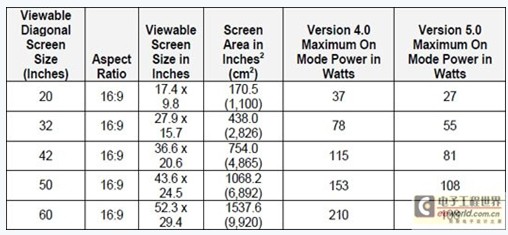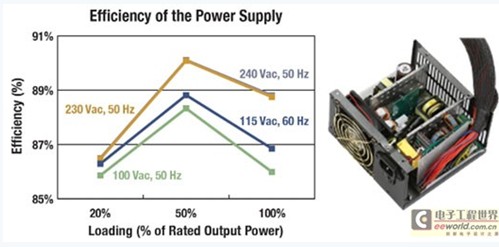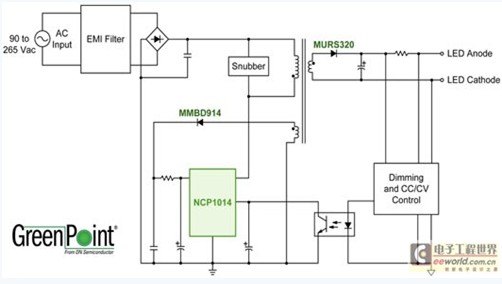Today, people are becoming more and more environmentally conscious, and energy conservation is not only a hot topic, but also a practical action item for important norms and industry leaders in various countries. Looking around our work and living environment, the most commonly used, most common or highly energy-efficient electronic appliances naturally become the first energy-saving action targets, such as computers, flat-panel TVs, set-top boxes, adapters/external power supplies, and light-emitting diodes (LEDs). ) Lighting, etc. Important global regulatory agencies, such as the US "Energy Star", the United States 80 PLUS, the European Energy Efficiency Code of Conduct (COC), the European Union EuP, Japan Top Runner, China National Institute of Standardization, etc., for these key applications to release updates, more high Energy efficiency regulations enable electronic products to perform the same functions with less power and improve the efficiency of power usage.
Taking the multi-output desktop ATX power supply as an example, the 80 PLUS Silver Specification and the Computing Industry Climate Relief Action (CSCI) Silver Specification have been in effect since July 2009, requiring multiple output desktop ATX power supplies at rated output power of 20 The energy efficiency under conditions of %, 50% and 100% reached 85%, 88% and 85%, respectively. Subsequent 80 PLUS Gold and CSCI Gold specifications will be effective in July 2010, further increasing energy efficiency requirements to 87%, 90% and 87%.
Another example is the flat-panel TV. As the size increases, its energy consumption has increasingly become a concern in the industry. The ENERGY STAR specification for TV version 4.0 will take effect on May 1, 2010. This specification requires that the energy consumption of flat-panel TVs with 32-inch, 42-inch and 60-inch diagonal screens in the working mode are not More than 78 W, 115 W and 210 W, and the 5.0 version of the specification, which will take effect on May 1, 2012, further requires that the energy consumption of these flat-panel TVs does not exceed 55 W, 81 W and 108 W, see table 1. European EuP directives have similar requirements. In addition to requiring reduced operating energy consumption, these specifications also require reduced standby power consumption because the data shows that considerable power is consumed in standby mode. Energy efficiency specifications such as “Energy Star†currently require no more than 1 W for standby energy consumption, and may not exceed 0.3 W or even 0.1 W in the future.

In the adapter/external power supply widely used in products such as notebook computers, the "Energy Star" version 2.0 specification has been effective on November 1, 2008. Take the "Energy Star" version 2.0 external power supply specification as an example. This specification requires an external power supply with a output power greater than 49 W (typical products such as a notebook adapter) to increase the energy efficiency from 84% to 87% of the 1.1 version. Standby (empty) The energy consumption is reduced from no more than 750 mW to no more than 500 mW, and the power factor (PF) is also required to be no less than 0.9. The first and second phases of the EU EuP Ecodesign Directive 2005/32/EC Specification No 278/2009 will be effective as of April 2010 and April 2011, respectively. The first phase requires that the output power be greater than 51. The external power supply of W works at least 85%, the no-load energy consumption does not exceed 500 mW, and the second-stage no-load energy requirement remains unchanged, but the energy efficiency requirement is increased to 87%.
In addition to these applications, LED lighting or solid-state lighting (SSL) is now a hot application. The 1.0 version of the Energy Star SSL specification has been in effect since October 1, 2008, requiring off-state energy consumption. Zero, the minimum energy efficiency requirements vary according to the application (such as spotlights, outdoor lights, etc.), the power factor requirements, commercial applications are not less than 0.9, residential applications are not less than 0.7.
Power and LED lighting application design challenges
These critical power and LED lighting applications present a challenge for design engineers to increase energy efficiency, improve power factor, and increase product reliability.
Specifically, design engineers must strive to improve energy efficiency due to total energy efficiency requirements and thermal limitations, even in low-power applications (or light loads). In addition, power factor correction (PFC) is not required only at higher power levels, and PFC may be required at relatively lower power levels. In addition, these applications often face space-constrained problems, especially in applications that replace traditional light bulbs with LED lighting. Overall reliability is also very important. The input supply range is also wider and supports 277 Vac. In addition, there are some specific lighting requirements, such as triac dimming (TRIAC) dimming.
preventive solution
Addressing the design challenges of these critical power and LED lighting applications requires newer technologies or optimized power topologies and solutions.
In the case of flat-panel TV applications, in order to maximize energy efficiency, traditionally used cold cathode fluorescent lamp (CCFL) backlights can be replaced with emerging LED backlights, such as direct-lit backlights or edge-lit backlights, which not only contribute to slim TVs. Design also helps reduce energy consumption and improve energy efficiency. If you maintain a CCFL backlight that is still higher than the current ratio, you can also take different effective measures, such as reducing the number of lamps and reducing energy consumption under the condition of providing the same light output, or adopting a novel inverter driver scheme, such as LCD TV integrated power supply (LIPS) reduces power conversion segments, increases energy efficiency and reduces costs.
ON Semiconductor supports energy efficiency trends with leading products and solutions
As the premier supplier of high-performance, energy-efficient silicon solutions, ON Semiconductor provides power management and LED lighting solutions to save energy and help customers meet and exceed power supply standards around the world (work energy efficiency, standby power consumption, low quiescent current and Power factor correction, etc.), cost parity or lower than traditional solutions.
It is important to emphasize that ON Semiconductor uses a holistic approach to achieving energy efficiency, including:
1) Reduce standby (no load) energy consumption. This includes better topologies such as quasi-resonant (valley switches), closed PFC sections in 2-stage converters, and new techniques such as frequency back-going, skipping cycles, soft-hopping cycles, and high-voltage bootstrap circuits.
2) Improve the energy efficiency of the power supply. This includes using better devices such as field effect transistors (FETs) and diodes, as well as using better topologies such as frequency reversal, synchronous rectification, and quasi-resonant, full resonance, active clamping (flyback or forward) ) Soft switching technology.
3) Power factor correction (or reduction of harmonics). This includes combining the PFC with the main converter and optimizing the PFC control modes for the specified application and level, such as discontinuous conduction mode (DCM), critical conduction mode (CrM), or continuous conduction mode (CCM).
ON Semiconductor offers a wide range of leading products for these critical power and LED lighting applications, such as PFC controllers, AC-DC controllers, high voltage MOSFETs, LED drivers, rectifiers, secondary synchronous rectifier controllers, DC - DC (DC-DC) switching regulators and low dropout (LDO) regulators, based on these leading products to provide an energy efficient GreenPoint® reference design for ATX power supplies, notebook and printer power adapters, TVs, solid state lighting And other applications.

Figure 1: ON Semiconductor's 255 W power reference design with 85% more energy efficiency for ATX desktops
For example, ON Semiconductor's 255 W GreenPoint® power supply reference design for desktop ATX power supplies is more energy efficient at 100, 115, 230, and 240 Vac input voltage conditions and 25%, 50%, and 100% rated output power. 85%, in line with the 80 PLUS Silver Energy Efficiency Specification and the Energy Star 5.0 desktop power specification, and meets the IEC61000-3-2 power factor requirements, with a power factor greater than 0.95 at various input voltages. It is worth mentioning that these data are obtained at the end of the 41-length cable. After thorough testing, it is strong and cost-effective. It is a production-ready design, see Figure 1.
As another example, in general-purpose LED lighting applications, ON Semiconductor has redesigned a halogen lamp from a retail store using LED modules. The original 35 W halogen lamp has an input power of 41.7 W at 120 Vac and a brightness of 744 lumens. The LED desk lamp based on the LED module built by ON Semiconductor NCP1014 has an input power of only 10.9 W at 120 Vac, ie energy consumption. It is only 1/4 of the traditional halogen lamp, but the light output is higher than the halogen lamp, reaching 795 lumens. This new LED design with LED modules reduces both product size and energy savings. See Figure 2 for the circuit diagram of this LED module.

Figure 2: Circuit diagram of a lamp redesigned with an NCP1014-based LED module
ON Semiconductor aims to be the preferred supplier of high quality, cost effective, high performance power management solutions, in addition to introducing key control, drive and power conversion ICs, as well as high voltage MOSFET and rectifier products, and a rich rectifier package system Including the new SO-8 FL rectifier package, its thermal performance is almost as good as the DPAK compact package.
to sum up:
Critical power applications such as computers, flat-panel TVs, and adapters, as well as LED lighting applications, face higher energy efficiency requirements and present challenges for designers. ON Semiconductor currently builds advanced technologies and products for energy-efficient power and LED lighting applications, and is a complete solution provider, offering a differentiated GreenPoint® reference design that delivers high performance and low total system cost, improving both energy efficiency and efficiency. Standby energy consumption, while also providing a high power factor, to help customers meet or exceed the energy efficiency requirements of the world.
HOTEL SAFES
Safes are especially designed for short time secure storage of hotel guests` valuables and laptops.
Details:
A Hotel Safe is anti-drilling, anti-burglar and anti-force safe;
It can protect security of customers` luxurious or personal items in a hotel;
The safe is a side door safe with an independently installed board.
Hotel Safe
Hotel Safe ,Digital Safe Box ,Hotel Use Safe,Finger Print Safe
YONGFA INTELLIGENT TECHNOLOGY SECURITY CO., LTD. , http://www.yongfa-safe.com